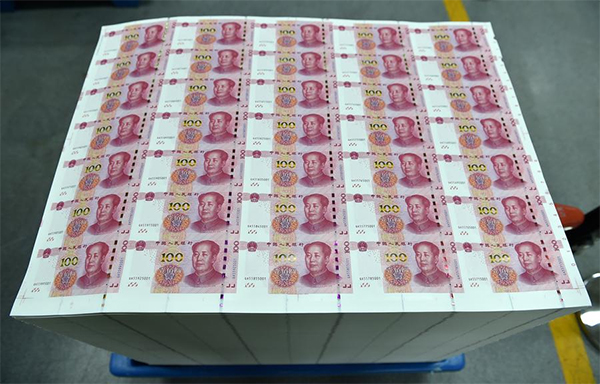Central bank sends more currency overseas to meet RMB demand
Updated: 2015-11-12 13:23
By Cui Jia in Shenzhen and Chen Jia in Beijing(chinadaily.com.cn)
|
|||||||||||
 |
|
New 100-yuan notes wheeled out in the factory of China Banknote Printing and Minting Corporation, Oct 29. [Photo/Xinhua] |
The People's Bank of China, which issued a new 100 yuan note today, has been transporting ever increasing quantities of renminbi to foreign countries to meet a growing demand for China's currency.
The central bank transported 50 billion yuan ($7.9 billion) in cash to Hong Kong, the country's offshore RMB center, during the first nine months of the year, an increase of more than 46 percent year-on-year, according to a bank insider in Shenzhen.
"From 2004 to 2007, we shipped less than 5 billion yuan cash to Hong Kong every year. We transported about 27 billion yuan cash annually since the demand for RMB cash surged in 2008," said Zhang Jianjun, director of the central bank's subcentral branch in Shenzhen, Guangdong province, which is responsible for 83 percent of China's cross-border RMB cash transportation in China.
In 2007, the central bank launched the first offshore RMB cash storage in Hong Kong managed by the Bank of China, which provides cash and flow-back services for overseas markets. So far, 221 foreign banks from 19 countries in Asia, North America, Europe, Oceania and Africa, have opened cash accounts with RMB Clearing Banks in Hong Kong.
RMB cash mainly crosses borders in one of two ways: carried by individuals and transported by commercial banks.
Since 2005, Chinese citizens and foreigners who leave or enter the country can carry no more than 20,000 yuan per person.
Chinese commercial banks in border areas cooperate with banks in neighboring countries on cash transportation, based on the bilateral local currency settlement agreements for border trade.
The central bank also authorized offshore RMB clearing banks in Hong Kong and Taiwan to transport cash.
The volume of cross-border RMB cash transported by banks is steadily increasing, according to a statement from the central bank. Last year, RMB cash transported in China reached 39.9 billion yuan, while 11.7 billion yuan was transported out. The total transported amount rose 23.2 percent from a year earlier.
"The increasing use of RMB cash in offshore markets will promote outbound tourism and business, as well as strengthen confidence of RMB internationalization among overseas investors," said Lo Pingwa, head of the Bank-wide Operation Department of Bank of China in Hong Kong.
The latest report from global transaction service provider SWIFT showed that the RMB remains the fifth-largest international payment currency by value, and accounted for 2.45 percent of global payments in September.
Michael Moon, head of payments for Asia Pacific at SWIFT, said that it is important to note that the RMBs underlying growth is trending positive.
"Such a trend is supported by an increasing number of corporates adopting the RMB for trade settlements, and a rising number of banks supporting those payments," Moon said.
The central regards the RMB note as China's business card and the new optical features of the 2015 version of the 100 yuan banknote are designed to improve protection against counterfeiting, with some advanced technologies especially developed for vending machines and ATMs.
The changes also make it easier for the public to discern a fake banknote, as the new note shows a more obvious security strip and a special color for the central "100".
Currency detectors designed to detect counterfeit RMB notes have been upgraded for the new notes in domestic and foreign banks.
Today's Top News
Schengen agreement under threat: Tusk
China's migrant population expected to reach 291m by 2020
China sends more currency overseas to meet demand
Little Chinese speakers hatch in UK's first bilingual nursery
China mourns death of former German chancellor
Former envoy recalls 'China hand' Helmut Schmidt
Alibaba breaks sales record on Nov 11 shopping spree
Britain's Cameron appeals to EU reform doubters
Hot Topics
Lunar probe , China growth forecasts, Emission rules get tougher, China seen through 'colored lens', International board,
Editor's Picks

|

|

|

|

|

|






